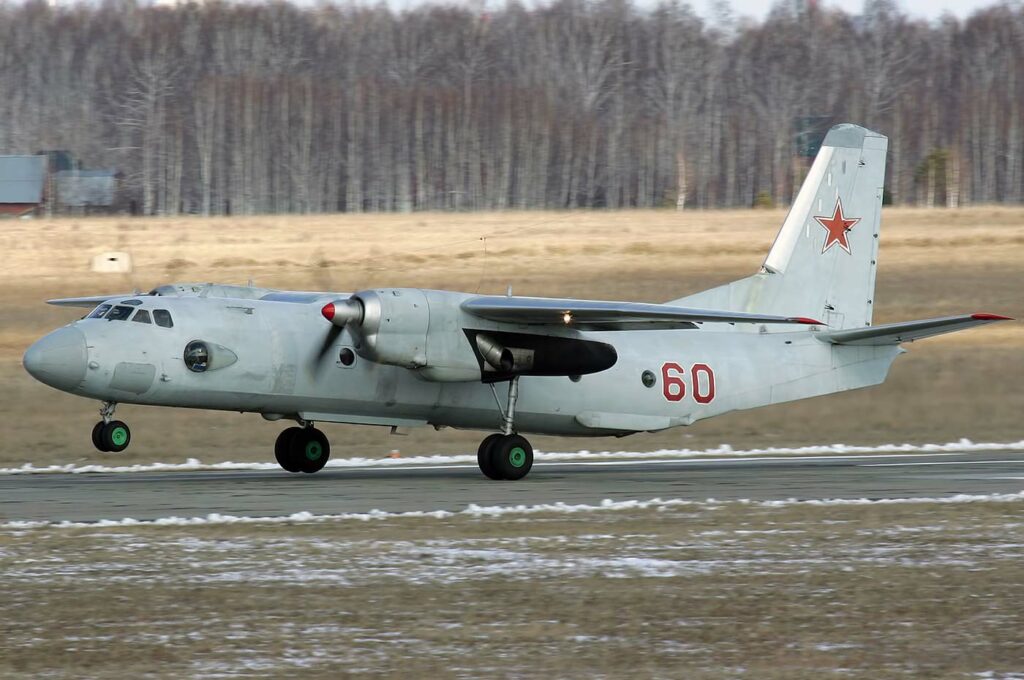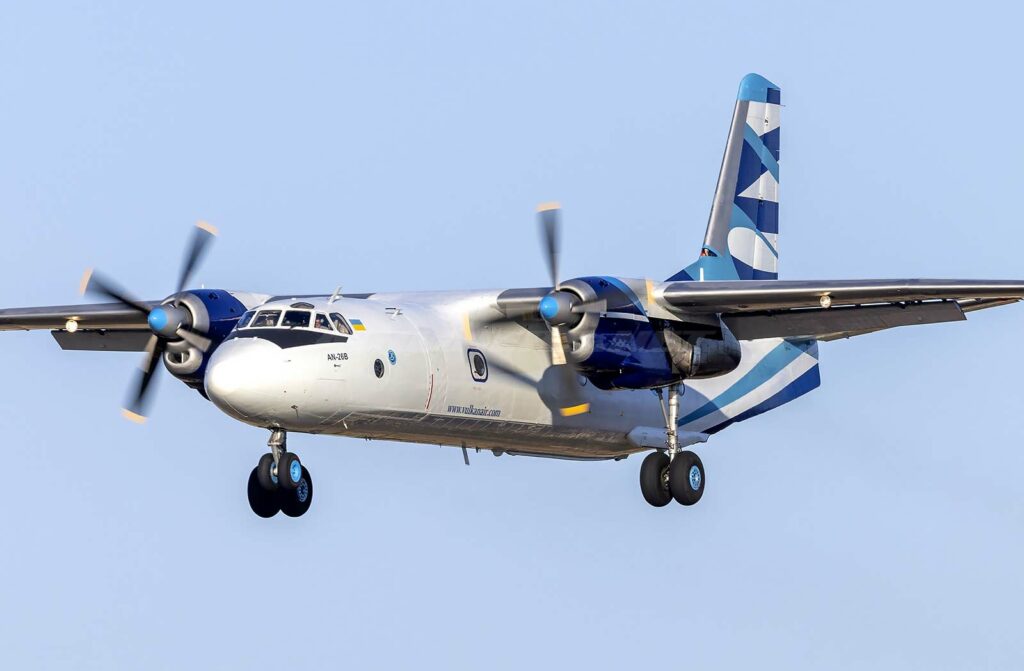The Antonov An-26 Curl is a versatile twin-engine turboprop military transport aircraft, renowned for its robustness and utility in various operations.
In brief
The Antonov An-26, NATO codename “Curl,” is a twin-engine turboprop transport aircraft developed in the Soviet Union by the Antonov Design Bureau. An evolution of the An-24, it was designed for both military and civil operations, featuring a rear ramp door for easy loading and unloading. Introduced in the 1960s, it became a staple for logistical support, capable of operating from rough, unpaved runways. Equipped with advanced navigation systems, it served in a variety of roles, including cargo transport, troop transport, and medevac operations. Its durability, versatility, and adaptability to various environments made it a valuable asset in numerous air fleets worldwide.

History of the Development of the Antonov An-26 (Curl)
The Antonov An-26 was developed in response to the Soviet military’s need for an improved, versatile transport aircraft capable of operating in diverse and challenging conditions. Building on the success of its predecessor, the An-24, the An-26 was designed in the late 1960s to meet the demands for increased payload capacity, enhanced versatility in cargo handling, and improved operational range.
The development was driven by the Antonov Design Bureau, a leading Soviet aircraft design collective, known for producing aircraft that could operate in the vast and varied geography of the USSR. The program was launched with the goal of creating an aircraft that could perform regular transport duties, airdrop paratroopers, carry out medevac missions, and serve in various other logistical roles.
The An-26 first took to the skies on May 21, 1969, showcasing significant advancements over its predecessor, including a redesigned rear fuselage with a ramp door for easier loading and unloading, increased payload capacity, and enhanced avionics. Its NATO reporting name “Curl” was assigned as part of the standard NATO practice to give code names to Soviet aircraft for identification in military operations and intelligence reports.
Design of the Antonov An-26 (Curl)
The Antonov An-26 is distinguished by its high-wing configuration, which facilitates stable flight characteristics and offers excellent visibility for the crew. The aircraft is powered by two Ivchenko AI-24VT turboprop engines, ensuring reliable performance and efficiency in various conditions. The An-26’s design incorporates a unique combination of a robust airframe and a retractable landing gear, making it well-suited for operations from unprepared runways.
One of the key features of the An-26 is its large cargo ramp at the rear, which, along with the aircraft’s ability to perform short takeoff and landing (STOL), makes it ideal for transporting troops, equipment, and supplies. The cabin is designed to be easily reconfigurable, accommodating cargo, passengers, or a combination of both. It also includes provisions for medical evacuation missions, underscoring its multipurpose utility.
The aircraft’s avionics are tailored to support its varied mission profile, featuring navigation and communication systems that enable it to operate in remote areas and under challenging conditions. However, the An-26’s technology, while robust, reflects the era of its design, with some systems now considered outdated compared to modern aircraft.
Performance of the Antonov An-26 (Curl)
The An-26 is renowned for its solid performance, particularly in short-haul transport missions. The twin Ivchenko AI-24VT engines, each producing 2,820 horsepower, allow the aircraft to reach a maximum speed of approximately 540 km/h (335 mph), with a standard cruising speed of around 440 km/h (273 mph). The aircraft possesses a commendable range of about 2,500 kilometers (1,550 miles) with maximum payload, and it can reach a service ceiling of up to 7,500 meters (24,600 feet).
Its STOL capabilities ensure that it can operate from short and rudimentary airstrips, enhancing its versatility in deploying troops and supplies. The An-26’s performance in austere conditions is bolstered by its rugged design, enabling it to land on and take off from unprepared runways, which is a significant advantage in military operations and humanitarian missions alike.
Comparatively, the An-26 holds its own against Western counterparts like the C-130 Hercules in certain aspects, especially in operating from rough, short runways. However, it generally carries a smaller payload and has a shorter range than the larger C-130.
Variants of the Antonov An-26 (Curl)
The Antonov An-26 has several variants, each designed to cater to specific operational requirements while maintaining the versatility inherent in the original design:
- An-26: The initial production model, featuring a unique combination of a ramp door and a passenger door, versatile for mixed cargo and passenger operations.
- An-26B: An improved version with enhanced avionics, increased maximum payload, and the introduction of specialized equipment for different roles, including aerial surveying, medical evacuation, and electronic intelligence gathering.
- An-26P: A fire-fighting variant equipped with tanks for dispensing water or fire retardant chemicals, demonstrating the adaptability of the An-26 platform for specialized civil service roles.
- An-26M: A dedicated medevac variant, outfitted with medical equipment to transport wounded or sick patients, complete with facilities for medical personnel to provide in-flight care.
- An-26Sh: A specialized classroom and training variant, the aircraft is configured as a flying classroom for navigational training, with desks, training equipment, and stations for students.
Each variant of the An-26 underscores the aircraft’s remarkable adaptability to various civil and military operations, extending its utility far beyond its original cargo transport role.

Military Use and Combat of the Antonov An-26 (Curl)
The Antonov An-26 has been extensively used in military operations across various countries and conflict zones. Its primary role in military contexts has been for tactical transport, delivering troops, supplies, and equipment to frontline areas. The aircraft’s robust design and short takeoff and landing capabilities made it ideal for operating in austere environments, often with unprepared or semi-prepared runways.
In combat scenarios, the An-26 has been utilized for airdropping paratroopers and cargo, medical evacuation, and even as a makeshift gunship in certain modifications. Its involvement in conflicts includes extensive use during the Soviet-Afghan War, where it was used to transport troops, equipment, and also for casualty evacuation. Its ability to operate in challenging conditions with minimal ground support made it invaluable in the rugged terrain of Afghanistan.
The An-26 has also seen service in numerous African conflicts, providing crucial logistics support in environments often lacking in infrastructure. Its role in these conflicts often extended beyond mere transport, as the aircraft was sometimes used for reconnaissance, signal intelligence, and light bombing, especially in variants modified by their operators for such purposes.
Despite its non-combatant design, the An-26 has occasionally been a target in conflicts. Some aircraft were lost to anti-aircraft fire, highlighting the risks involved in its operational use in contested airspaces. The versatility and reliability of the An-26, however, have ensured its continued use even in the face of such threats.
Internationally, the An-26 has been widely exported and is used by air forces, civil operators, and humanitarian agencies worldwide. Its enduring presence in various regions underscores its reliability and the high regard in which it is held by its operators. However, with advancements in aviation technology and the advent of newer transport aircraft, many operators have started phasing out the An-26, replacing it with more modern, efficient, and capable platforms.
The Antonov An-26 Curl represents a significant achievement in the field of military transport aviation, embodying the characteristics of ruggedness, versatility, and reliability. Developed to meet the pressing needs of the Soviet military for a robust tactical airlifter, the An-26 has far exceeded its original design expectations, serving countless operators across the globe in various capacities, both military and civilian.
Its wide range of variants and the extensive use in different operational scenarios reflect the aircraft’s adaptability and capability to perform under demanding conditions. While newer technologies and aircraft designs have emerged, the An-26 continues to hold a place in the annals of aviation history, recognized for its substantial contributions to military and civilian operations worldwide.
Back to Transport planes.